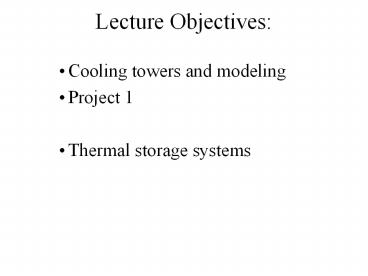Lecture Objectives: - PowerPoint PPT Presentation
Title:
Lecture Objectives:
Description:
Lecture Objectives: Cooling towers and modeling Project 1 Thermal storage systems Cooling Tower Performance Curve Most important variable is wet bulb temperature TCTS ... – PowerPoint PPT presentation
Number of Views:84
Avg rating:3.0/5.0
Title: Lecture Objectives:
1
Lecture Objectives
- Cooling towers and modeling
- Project 1
- Thermal storage systems
2
Cooling Tower Performance Curve
R
TCTR
Outdoor WBT
from chiller
TCTS
to chiller
Temperature difference R TCTR -TCTS
TCTS
Most important variable is wet bulb temperature
TCTS f( WBToutdoor air , TCTR , cooling tower
properties) or for a specific cooling tower
type TCTS f( WBToutdoor air , R)
WBT
3
Cooling Tower Model
Model which predict tower-leaving water
temperature (TCTS) for arbitrary entering water
temperature (TCTR) and outdoor air wet bulb
temperature (WBT)
Temperature difference R TCTR -TCTS
Model
For HW 3b You will need to find coefficient a4,
b4, c4, d4, e4, f4, g4, h4, and i4 based on the
graph from the previous slide and two variable
function fitting procedure
4
Combining Chiller and Cooling Tower Models
Function of TCTS
3 equations from previous slide
Add your equation for TCTS
? 4 equation with 4 unknowns (you will need to
calculate R based on water flow in the cooling
tower loop)
5
Merging Two Models
Temperature difference R TCTR -TCTS
Model
Link between the chiller and tower models is the
Q released on the condenser Q condenser
Qcooling Pcompressor - First law of
Thermodynamics
Q condenser (mcp)water form tower (TCTR-TCTS)
m cooling tower is given - property
of a tower TCTR TCTS - Q condenser /
(mcp)water
Finally Find P(?) or The only fixed variable
is TCWS 5C (38F) and Pnominal and Qnominal for
a chiller (defined in nominal operation
condition TCST and TCSW) Based on Q(?) and WBT
you can find P(?) and COP(?).
6
Two variable function fitting(example for a
variable sped pump)
7
Function fitting for a chillerq f (condensing
and evaporating T)
8
Merging Two Models
Temperature difference R TCTR -TCTS
Model
Link between the chiller and tower models is the
Q released on the condenser Q condenser
Qcooling Pcompressor ) - First law of
Thermodynamics
Q condenser (mcp)water form tower (TCTR-TCTS)
m cooling tower is given - property
of a tower TCTR TCTS - Q condenser /
(mcp)water
Finally Find P(?) or The only fixed variable
is TCWS 5C (38F) and Pnominal and Qnominal for
a chiller (defined in nominal operation
condition TCST and TCSW) Based on Q(?) and WBT
you can find P(?) and COP(?).
9
Low Order Building Modeling
Measured data or Detailed modeling Find Q(?)
f (DBT)
10
For Austins Office Building
Model (Area 125,000sf)
Hours in a year
kW
Used for component capacity analysis
Model
0 when building is off
Number of hours
11
For project 1 you will need Q(?)for each hour
Yearly based analysis You will need Q(?) for
one week in July Use simple molded below and the
Syracuse TMY2 weather file posted in the course
handout section
12
Example of CHP Cooling
We need a thermal storage somewhere in this
system !
13
Thermal storage
- Store heat
- Many issues to consider (?T, pressure, losses,.
) - Store cooling energy
- Chilled water
- For cooling condenser
- For use in AHU (cooling coils)
- Ice storage
- Compact but
- Other materials (PCMs) that change phase the
temperature we need in cooling coils - Many advantages, but disadvantages too!
14
On-Peak and Off-Peak Periods
This profile depends on the type of building(s) !
15
Chilled water tank
Use of stored cooling energy
Store
Use
16
Which one is better ?
- Depends on what you
- want to achieve
- Peak electric power reduction
- Capacity reduction
- ..
17
Downsizing the Chiller
- Lower utility costs
- Lower on-peak electrical consumption(kWh)
- Lower on-peak electrical demand (kW)
- Smaller equipment size
- Smaller chiller
- Smaller electrical service (A)
- Reduced installed cost
- May qualify for utility rebates or other
incentives

